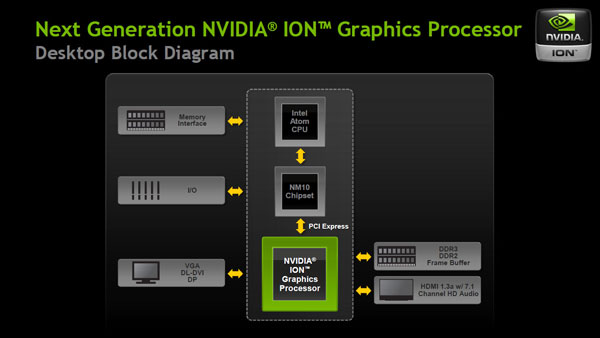New Driver Enables Smooth 1080p Flash Playback on NVIDIA NG-ION
by Anand Lal Shimpi on June 10, 2010 10:15 AM EST- Posted in
- GPUs
- Flash GPU Acceleration
- Next Generation ION
- ZOTAC
- NVIDIA
Last month I reviewed Zotac’s first Next-Generation ION nettop, the ZBOX HD-ID11. The chassis and feature set haven’t really changed much since the ION1 based ZBOXes, the only real difference is the HD-ID11 has Pine Trail and NVIDIA NG-ION inside. Unfortunately, in some cases, that’s not exactly an upgrade over the previous platform.
The original ION platform was a chipset and integrated graphics solution in a single package that stemmed off the Atom CPU. For a bunch of licensing reasons I described here, NVIDIA wasn’t allowed to build a similar chipset for the new Pine Trail Atom platform and thus had to come up with another solution. The next-generation ION now branches off Intel’s Pine Trail chipset, typically via a single PCIe 1.0 lane offering only 250MB/s of bandwidth to/from the chipset.

This results in a bandwidth bottleneck that can make bandwidth intensive GPU operations (e.g. 3D gaming) worse than the original ION. I suspect most folks don’t buy ION systems to game on them, so the bigger concern is another bandwidth intensive GPU operation: Flash video acceleration.
When you play back a GPU accelerated Flash video stream using Flash 10.1 on a Next Generation ION system the frames are sent to the GPU for decoding but then sent back to the CPU for compositing and finally copied back to the GPU’s frame buffer for display. In the Next Generation ION this happens over the meager PCIe 1.0 x1 interface. That’s thankfully bandwidth enough to decode, composite and display lower resolution Flash video, but not enough for 1080p.
Using current drivers if you try to play a 1080p YouTube HD stream on a Next Generation ION you’ll drop frames because of this bandwidth limitation. It gets worse if you decode and play the stream full screen at a 1080p desktop resolution. As I pointed out in my Next Generation ION review, even playing 480p Hulu content scaled up to 1080p dropped frames. It’s a real problem.

There is an obvious solution: do the entire process on the GPU itself, thus avoiding the copying back and forth over the PCIe x1 connection. NVIDIA told me this was possible, but it required a driver update. I now have that driver update: version 257.29.
The driver isn’t publicly available, although NVIDIA is shooting to have a public beta on June 28th with a WHQL release sometime in July.
I tested the driver with the latest Adobe Flash 10.1 beta (release candidate 7) and the NVIDIA press preview driver I mentioned above. I fired up YouTube in Chrome and picked a 1080p clip.
CPU utilization before and after the updated driver remains the same at around 15 - 20% of the Atom D510’s four threads. But this isn’t a CPU utilization problem. Using the current public driver the 1080p stream is unwatchable at full screen, the system drops a ton of frames. Using the updated driver? Smooth as butter.

It’s not all good news though. The frame rate will drop the minute you move your mouse and reveal the playback controls. That compositing still happens on the CPU. In fact anything that appears over the video kills frame rate. You can stop the playback controls from coming up by simply not moving your mouse, but a YouTube ad appearing over the video is less predictable.
Hulu continues to be a problem. Even a 360p video scaled up to 1080p will drop frames with the new driver. NVIDIA is aware of the issue and is working on it. To NVIDIA’s credit, Hulu has always posed problems for GPU acceleration ever since the Flash 10.1 betas hit.
The new driver definitely makes things better and it looks like NVIDIA is committed to improving the experience even further. But at this point, the original ION is still better for Flash video playback. If you’re using the NG-ION as a more traditional HTPC, playing files stored on your network and not streamed in a Flash movie then you’re of course fine. Read our Zotac ZBOX HD-ID11 Review for more on how the Next Generation ION performs in HTPC and other scenarios.










27 Comments
View All Comments
sprockkets - Thursday, June 10, 2010 - link
If you get the nvidia itx 9300 board it will be a non issueclarkn0va - Thursday, June 10, 2010 - link
I can't think of one good reason to choose NG over the original ION. I have a first-gen Zotac ION-itx board and have enjoyed hours of 1080p goodness without issue.When Pine Trail was fresh I had hoped it would reduce power consumption significantly, but having toyed with a few systems I haven't really found that to be the case. My Zotac (Atom 330) with 2 3.5" drives runs around 36W (on a brick) under light load, which is very close to what I've seen on a couple D510 systems.
sprockkets - Thursday, June 10, 2010 - link
If you actually looked at the review, aside from this dumb issue, everything else about it is faster.BernardP - Thursday, June 10, 2010 - link
All the pieces are coming together for GPU-accelerated Flash video except...er... the final release of the required Flash update.Per Hansson - Friday, June 11, 2010 - link
Not any more :)http://www.techspot.com/news/39269-adobe-releases-...
Taft12 - Thursday, June 10, 2010 - link
Intel's refusal to license 3rd party chipsets for their CPUs is flat-out horseshit and worthy of antitrust action. Using a PCIE x1 lane is a terrible way to combine a GPU with Atom/NM10, but Nvidia have no choice but to spread 'em for Intel and their artificial limitation.Beaver M. - Thursday, June 17, 2010 - link
Intel doesnt realize that its sales of the Atom will drop horribly when they cant be run with the ION properly.Seriously, the Atom is a POS without ION, and many people know that.
I would have never bought one if the ION wouldnt have been there.
Even a faster GMA from Intel wouldnt help the Atom much, because they wouldnt support GPGPU. The Atom NEEDS GPGPU to be somewhat viable.
Lonyo - Thursday, June 10, 2010 - link
Do these playback issues occur with HTML 5 based video playback? Is h264 hardware supported? (I don't know how it works).sprockkets - Thursday, June 10, 2010 - link
look for dxa support. I sidestep the whole issue by simply ripping the flash videos from the website and playing them with smplayer.Klinky1984 - Thursday, June 10, 2010 - link
I wonder if there is a way that nVidia could losslessly compress the uncompressed portions of data in real-time. A lot of times you can get 2:1 reductions using just lossless compression on an uncompressed source. Though if this were implemented in Flash or by nVidia it would probably require more CPU power to decode the compressed stream, though perhaps not enough to cause stutter.